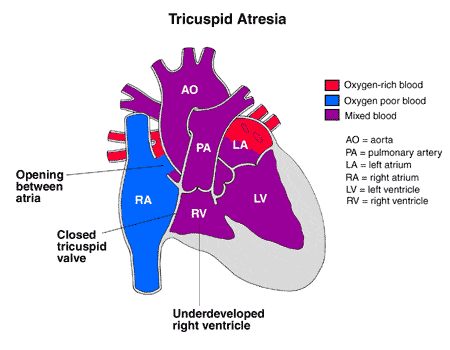
Tricuspid atresia is a congenital heart defect (present at birth). It happens when the tricuspid valve does not form properly during the first two months of pregnancy.
The tricuspid valve is the passageway between the right atrium and right ventricle. In tricuspid atresia, the valve doesn't develop normally and blood cannot flow from the right atrium into the right ventricle. Without the normal blood flow to help it grow the right ventricle doesn’t fully develop. This is one type of a single ventricle defect. With only one working ventricle, babies born with tricuspid atresia may have mild to extreme difficulty pumping oxygen-rich blood to the body.
In tricuspid atresia, the following occurs:
- Improper development of the tricuspid valve: Prevents oxygen-poor (blue) blood from passing from the right atrium to the right ventricle and on to the lungs.
- Underdeveloped right ventricle: The right ventricle is too small.
- Atrial septal and ventricular septal defects: Associated defects that are needed to allow the oxygen-poor (blue) blood and oxygen-rich (red) blood to mix with each other.
- Patent ductus arteriosus: Allows blood to pass through from the aorta to the pulmonary artery and receive oxygen from the lungs.




